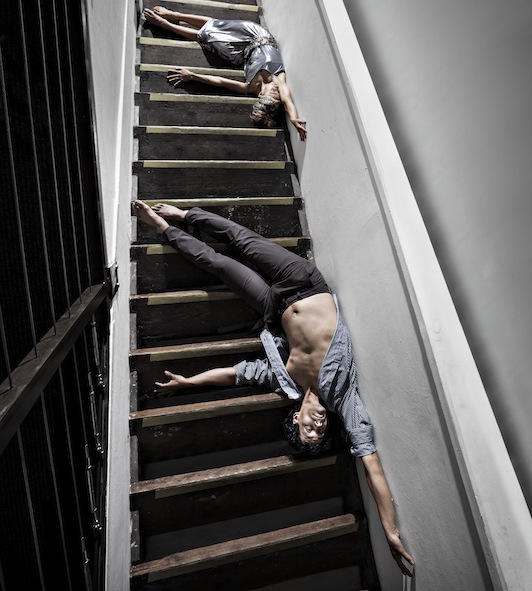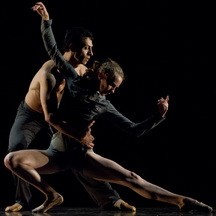
Shifting dimensions
In the darkened space divided by long dark curtains, three of us are silently directed to duck under a scrim, step up on a low platform and lift our head and shoulders into a round opening. What we see in the hidden space above is a miniature landscape. There are rolling green hills, a farmhouse in the distance, groups of black-and-white cows grazing under trees. Everything is tiny, the cows perhaps an inch in length. But everything looks larger, in the scale of the real world, only distant, separated as it is from the space we feel our bodies normally inhabit.
Suddenly in this pastoral world of ambiguous scale, an enormous head appears – over there, by the farmhouse, on the other side of the cows. It’s vaguely reminiscent of the Wizard of Oz’s enormous, disembodied head. And it speaks to us, talking of love. Have we ever, the head asks, tried to force someone to love us? Have we ever been “love bullies”?
We know this head: it belongs to Joe Goode, the choreographer of The Poetics of Space, recently opened at the Joe Goode Annex, in collaboration with Z Space in the Project Artaud arts complex in San Francisco.
If we hadn’t met Joe Goode before that evening, we certainly met him in the lobby, where he climbed up a terrifyingly vertical ladder to address us as we lingered there waiting for the performance to begin. High above us, white makeup on his face and hands, he tells us that he is “a representative of the dead.” The performance that follows is about the dead, or rather one specific dead person, Logan.
A human story
Logan existed, like the rest of us, in space, and a narrow space of time. His story is revealed in short vignettes that occur in different spaces and times throughout the Annex. The performance space is divided by long curtains and three levels of platforms. The audience moves through the changing and changeable space, along with the dancers, who direct viewers, assist, move curtains and flats, dance and enact Logan’s short life, confounded by desire, thwarted love, and unrelenting yearning.
The piece is a provocative mélange of dance, theater and story telling. Its strongest suit is the dancers and their relative proximity to the audience. There is something thrilling about being close to dancers, to having the fourth wall so decidedly dissolved. And to hear, for instance, the voices of other stories being told elsewhere in other spaces in the Annex. We recognize the dancers from their tinsel wigs, sequined tops, shimmering youth and the way they move through us, assured and purposeful. We feel less so. In a way, we are lost. The small amount of agency that we checked at the theater door is finally wrested from us, and we are left vulnerable to the experiment. The fact that we are moving in the moment and have a role to play that we are unsure of makes us additionally vulnerable and therefore, open: open to what is revealed by the body in space, which through being physical becomes more than physical.
It is this aspect perhaps more than any other that aligns Goode’s experiment with Bachelard’s philosophy. The choreographer used Bachelard’s classic of phenomenology, The Poetics of Space, as his inspiration, although he claims his piece is not “a Bachelard performance.”
Even so, it is a primary tenet of phenomenology that we move closer to a true understanding of life when we abandon stereotypical or habitual thinking. Once we have done that we can meditate on the objects of life that stand before us, sharing our consciousness and reminding us over and over that we are not alone, and that we are part of a greater – and miraculous – universe. And it is here, to this space, that Joe Goode brings us.
– Jaime Robles
The Poetics of Space continues through November 1, at the Joe Goode Annex, 401 Alabama Street, in San Francisco. For information and tickets, visit www.joegoode.org, www.zspace.org or call 866-811-4111.
Photo: Felipe Barrueto-Cabello and Marit Brook-Kothlow check out the available space in Joe Goode’s “The Poetics of Space”. Photo by RJ Muna.
